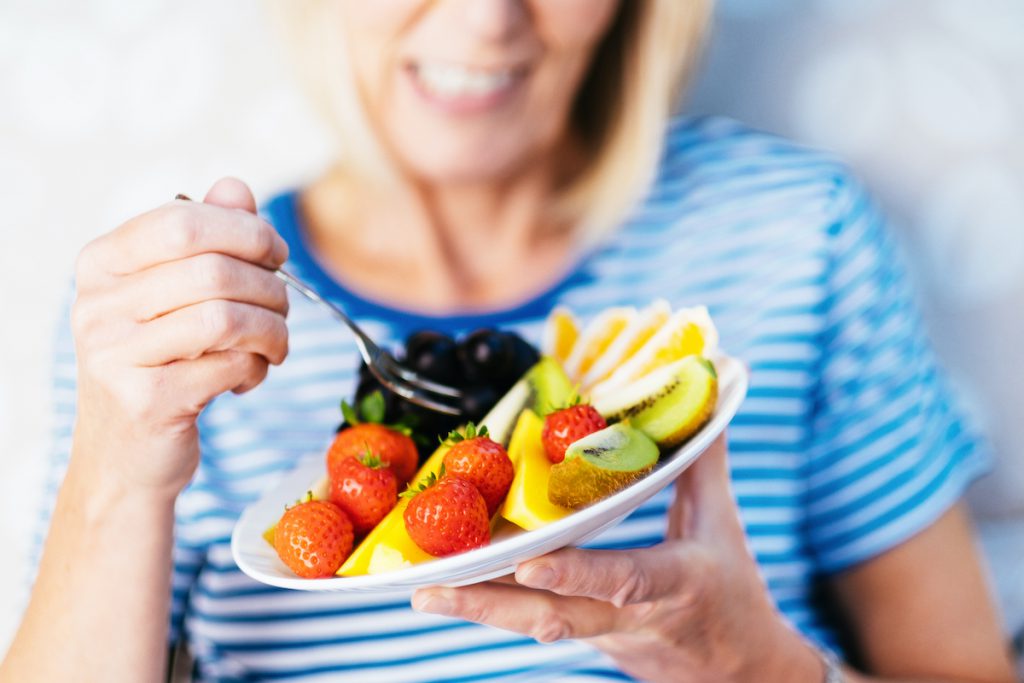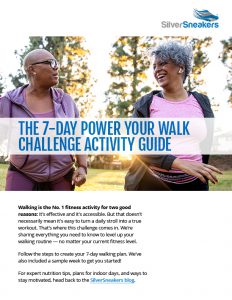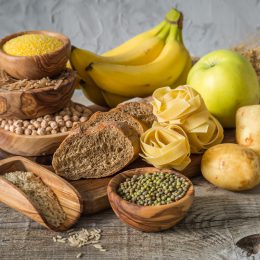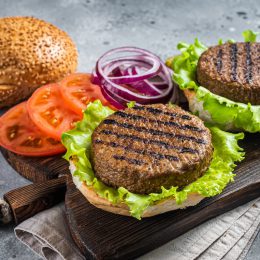Power Your Walk Challenge: Eat Right to Walk Strong
Nutrition experts answer your top questions about fueling to walk your best.

This is Step #5 of the 7-Day Power Your Walk Challenge. Find the full step-by-step guide here. And download the activity guide here. Enjoy your walk!
Walking your best isn’t just about lacing up your shoes and pumping up the intensity. How you take care of your body as a whole matters, too. And that includes what you put on your plate.
“Fueling for performance is similar to topping off our car’s gas tank or doing an oil change before we go on a long drive,” says Angel Planells, R.D.N., a Seattle-based registered dietitian nutritionist and spokesperson for the Academy of Nutrition & Dietetics.
“A short walk may not require a lot of energy but eating well and staying hydrated will allow you to feel good (inside and out) and finish strong,” adds Planells.
As you get older, this becomes even more important.
“Our bodies may not be as efficient in absorbing or metabolizing nutrients when we’re 65 versus when we’re 25,” she says.
If you’re not fulfilling your nutrition needs at rest, there’s a good chance your needs during movement won’t be met, either.
So what exactly are those needs? And do you need to eat differently when you’re walking faster or longer?
Here, nutrition experts answer these and other common questions about fueling for performance.
Question #1: What foods should I eat to improve my walking workouts?
To put it simply: the ones you like, and that nourish your body, says Planells.
To boost your walking performance, you don’t need any fancy meal plans or diets. You just have to work on improving your diet, little by little.
Planells says that there are lots of ways to add more nutrition to your diet:
- Eat more fruits and vegetables.
- Swap refined grains for whole grains, such as whole wheat bread.
- Fill your plate with enough protein. (This is how much protein you should eat in a day.)
- Be sure your diet has variety. (This will help make sure you get enough vitamins and minerals.)
- Cook at home when you can. (Food we eat out tends to be higher in sodium and harmful fats. Check out our recipes for inspiration.)
- Drink enough water. (More on that below.)
Feeling overwhelmed? You don’t have to overhaul your diet all at once.
“Rome wasn’t built in a day,” says Planells. “Choose one or two things to implement and gradually add on from there.”
This will help you make lasting, sustainable changes that fit your culture, lifestyle, and needs.
Question #2: I want to lose weight. Does that mean I should eat less and walk more?
In theory, the move more, eat less tactic can work. But the goal here is to walk strong — for life.
When people go on a diet or try to lose weight, they tend to focus on what foods to cut, rather than what foods to add. So first, look at the above list and see what could be lacking in your diet.
If you eat more nutrient- and fiber-rich foods, you’ll naturally have less room for the not-so-healthy stuff that might be sabotaging your weight loss.
Another thing: Make sure you actually need to lose weight. If you’re unsure or are managing a chronic condition, consult your doctor or dietitian.
Recommended reading: Your 3-step guide to losing weight (and keeping muscle)
Question #3: My new walking workouts are making me hungrier. What gives?
Well, you may simply need to fuel up.
“If you’re feeling hungry or tired, then that means we’re challenging the body,” explains Michael Lynch, R.D., a registered dietitian, clinical exercise physiologist, and owner of Nutrition with Heart in Edmonds, Washington. “And you may not have the nutrient or hydration status to properly support this additional movement.”
In other words, are you eating enough — and of the right foods — to fuel your body and your increase in activity?
If it’s been less than 3 hours since you last ate, it’s worth checking in on why you might be feeling hungry, too. We can also perceive hunger if we’re bored, sluggish, tired, dehydrated, or stressed, explains Lynch.
“The human body is programmed to feel hungrier the more idle we are,” he says.
When you’re at rest, most of your blood flow is in the middle of your body, at your digestive system. But when you start to move, it fans out to feed your muscles with needed oxygen and nutrients. Along with hormone changes, this can make the latter type of hunger go away.
So when you’re feeling hungry, ask yourself: Does my body need fuel? (You’re working harder, after all.) Or do I just need to lace up my shoes and go for a walk?
Question #4: Does it matter when I eat before, during, and after my walking workouts?
Everyone is different. What matters most is that you feel fueled (and hydrated) to walk your best.
That said, there are a few general rules of thumb that can be helpful to follow and boost recovery.
If it’s been more than 3 hours since you last ate, check in with yourself to see if you need a pick-me-up before you head out, says Lynch.
Before workouts, opt for a carbohydrate-rich snack that’s easy to digest. This might be a piece of fruit, such as a banana or apple, or a handful of whole-wheat crackers.
If your walk is under 60 minutes, then you generally don’t need to fuel during it, says Lynch. But if it’s more than that, then you may want to eat a snack about 30 minutes in to help you finish strong. This could be some trail mix or, again, a piece of fruit.
When you’re done with your walk, your body is primed to take in water and nutrients. If you sense you need to eat something, go for it.
“At the same time, if a nice refreshing glass of water fits the bill, then you can certainly wait until your next meal to refuel,” says Lynch.
Question #5: How do I tell if I’m drinking enough water?
You may not want to rely on thirst alone. “The thirst mechanism gets blunted as we age,” explains Planells.
Subscribe to our newsletter
It's quick and easy. You could be one of the 13 million people who are eligible.
Already a member? Click to discover our 15,000+ participating locations.
Follow Us
So the best way to tell if you’re hydrated is to look down. “If your urine is clear to light yellow you’re on the right track,” says Planells.
“However, if it starts to get a darker tinge, you’ll need to increase your intake.” (Here are 5 other sneaky signs you’re dehydrated.)
It’s especially important to pay attention to this when the weather gets hot or you’re sweating more on your walks. In both cases, your body needs more fluids to help lubricate joints and function at its best.
How do you drink more water? It’s best to sip throughout the day. Aim to drink a glass of water with meals and when you get back from your walk.
You may also want to bring a beverage with you on your walks to prevent dehydration in the first place.
Now, get out there and crush your workouts!
Here are the other steps in the 7-Day Power Your Walk Challenge:
Step #1: Pick a Power Your Walk Challenge Walking Plan
Step #2: Find Your Walking Workouts
Step #3: Stretch to Ease Achy Joints and Boost Mobility
Step #4: Strengthen Your Muscles to Walk Tall and Prevent Injuries
Step #6: Have a Plan for Indoor Days
Step #7: Stay Committed to Your Walking Goals
Download the 7-Day Power Your Walk Challenge Activity Guide here.
Take Your Favorite SilverSneakers Classes Online!
SilverSneakers members can access live fitness classes and wellness workshops through SilverSneakers LIVE. See the latest schedule and RSVP for classes here.
Not a member? If you have a Medicare Plan, it may include SilverSneakers — at no additional cost. Check your eligibility instantly here.






